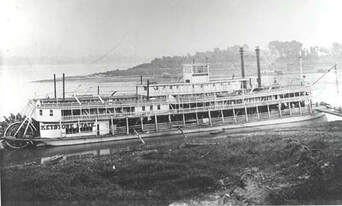Lost Treasure Ship – Keystone State
By James Donahue
Sunken ships rarely had treasure such as gold or jewelry on the Great Lakes. But there were a few exceptions. The side-wheeled steamship Keystone State was thought to have been carrying many thousands of dollars in gold and silver coins in its safe. The trick for many years was to find the wreck.
The Keystone State took thirty-three souls to their death when it disappeared on Saturday, November 9, 1861, somewhere on Lake Huron. Historians believed it sank somewhere off the tip of Michigan’s Thumb District. The vessel left Detroit on Friday bound for Milwaukee with passengers and a cargo of farm tools, crates of valuable china, and general merchandise. Her skipper was Wilkes Traverse, the mate was Lewis Rankin. Alexander Kent was the chief engineer.
The steamer encountered a furious storm on Lake Huron and never made port. She was last seen rolling heavily on high seas somewhere off Point aux Barques, Michigan. There were no survivors so the story of what happened to the ship was never told.
Wreckage, believed to be flotsam from the steamer, came ashore between Forestville, Michigan and Point aux Barques, some fifty miles to the north. The wheelhouse and other debris drifted ashore near Forestville during a gale on November 19, ten days after the Keystone State was believed to have been lost. Also that month the steamer Forest Queen reported wreckage off Point aux Barques, and the upper cabins and stanchions of a side-wheeled steamship washed ashore near White rock, a few miles north of Forestville.
Behold, the wreck was found in 2013 by Michigan diver Dave Trotter and other divers some 30 miles northeast of Harrisville, an estimated 50 miles from where it was last seen. The wreck sits upright about 175 feet at the bottom of Lake Huron. Trotter reports that the stern is broken up, but the engine and large side wheels are still in place. No mention was made of a treasure in the vessel’s safe.
The Keystone State was among the largest vessels on the lakes in its day. It measured about three hundred feet in length, thirty-four feet at the beam, and grossed thirteen hundred tons. One account said the ship was only two years old, built at Buffalo in 1859. Beer’s History of the Great Lakes, however, reports that it was an old steamer and had sailed for years between Buffalo and Chicago.
Some said the Keystone State was in poor repair on the day it sank. Sailors complained that the vessel was unwieldy and difficult to handle in heavy seas. And there was one other fatal flaw; the ship carried no lifeboats. When it sank the crew and passengers had no way of escape.
By James Donahue
Sunken ships rarely had treasure such as gold or jewelry on the Great Lakes. But there were a few exceptions. The side-wheeled steamship Keystone State was thought to have been carrying many thousands of dollars in gold and silver coins in its safe. The trick for many years was to find the wreck.
The Keystone State took thirty-three souls to their death when it disappeared on Saturday, November 9, 1861, somewhere on Lake Huron. Historians believed it sank somewhere off the tip of Michigan’s Thumb District. The vessel left Detroit on Friday bound for Milwaukee with passengers and a cargo of farm tools, crates of valuable china, and general merchandise. Her skipper was Wilkes Traverse, the mate was Lewis Rankin. Alexander Kent was the chief engineer.
The steamer encountered a furious storm on Lake Huron and never made port. She was last seen rolling heavily on high seas somewhere off Point aux Barques, Michigan. There were no survivors so the story of what happened to the ship was never told.
Wreckage, believed to be flotsam from the steamer, came ashore between Forestville, Michigan and Point aux Barques, some fifty miles to the north. The wheelhouse and other debris drifted ashore near Forestville during a gale on November 19, ten days after the Keystone State was believed to have been lost. Also that month the steamer Forest Queen reported wreckage off Point aux Barques, and the upper cabins and stanchions of a side-wheeled steamship washed ashore near White rock, a few miles north of Forestville.
Behold, the wreck was found in 2013 by Michigan diver Dave Trotter and other divers some 30 miles northeast of Harrisville, an estimated 50 miles from where it was last seen. The wreck sits upright about 175 feet at the bottom of Lake Huron. Trotter reports that the stern is broken up, but the engine and large side wheels are still in place. No mention was made of a treasure in the vessel’s safe.
The Keystone State was among the largest vessels on the lakes in its day. It measured about three hundred feet in length, thirty-four feet at the beam, and grossed thirteen hundred tons. One account said the ship was only two years old, built at Buffalo in 1859. Beer’s History of the Great Lakes, however, reports that it was an old steamer and had sailed for years between Buffalo and Chicago.
Some said the Keystone State was in poor repair on the day it sank. Sailors complained that the vessel was unwieldy and difficult to handle in heavy seas. And there was one other fatal flaw; the ship carried no lifeboats. When it sank the crew and passengers had no way of escape.
